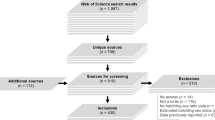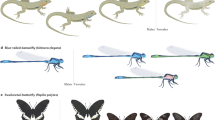Similar forces may select for gender switching across taxa in all animals with this facility.
Abstract
Sex change occurs in a variety of animals, including fish, echinoderms, crustaceans, molluscs and polychaete worms1. Here we show that the relative timing of sex change is surprisingly invariant across all animals: 91–97% of the variation in size at sex change across species can be explained by the simple rule that individuals change sex when they reach 72% of their maximum size. This suggests that there is a fundamental similarity across all animals, from a 2-mm-long crustacean to a 1.5-m-long fish (Fig. 1), in the underlying forces that select for sex change.
This is a preview of subscription content, access via your institution
Access options
Subscribe to this journal
Receive 51 print issues and online access
$199.00 per year
only $3.90 per issue
Buy this article
- Purchase on Springer Link
- Instant access to full article PDF
Prices may be subject to local taxes which are calculated during checkout


J. RANDALL
Similar content being viewed by others
References
Charnov, E. L. The Theory of Sex Allocation (Princeton Univ. Press, Princeton, 1982).
Charnov, E. L. Life History Invariants (Oxford Univ. Press, Oxford, 1993).
Warner, R. R. Trends Ecol. Evol. 3, 133–136 (1988).
Leigh, E. G. et al. Proc. Natl Acad. Sci. USA 73, 3655–3660 (1976).
Charnov, E. & Skuladottir, U. Evol. Ecol. Res. 2, 1067–1071 (2000).
Gemmill, A. W. et al. J. Evol. Biol. 12, 1148–1156 (1999).
Allsop, D. J. & West, S. A. J. Evol. Biol. 16, 921–929 (2003).
Felsenstein, J. Am. Nat. 125, 1–15 (1985).
Harvey, P. H. & Pagel, M. D. The Comparative Method in Evolutionary Biology (Oxford Univ. Press, Oxford, 1991).
Frank, S. A. Foundations of Social Evolution (Princeton Univ. Press, Princeton, 1998).
Author information
Authors and Affiliations
Corresponding author
Ethics declarations
Competing interests
The authors declare no competing financial interests.
Rights and permissions
About this article
Cite this article
Allsop, D., West, S. Changing sex at the same relative body size. Nature 425, 783–784 (2003). https://doi.org/10.1038/425783a
Issue Date:
DOI: https://doi.org/10.1038/425783a
This article is cited by
-
Factors influencing stoplight parrotfish territoriality and social structure in the middle Florida Keys
Environmental Biology of Fishes (2023)
-
Sex change as a survival strategy
Evolutionary Ecology (2020)
-
The relationship between sex change and reproductive success in a protandric marine gastropod
Scientific Reports (2016)
-
Sex change and effective population size: implications for population genetic studies in marine fish
Heredity (2016)
-
Relative size-at-sex-change in parrotfishes across the Caribbean: is there variance in a supposed life-history invariant?
Evolutionary Ecology (2011)
Comments
By submitting a comment you agree to abide by our Terms and Community Guidelines. If you find something abusive or that does not comply with our terms or guidelines please flag it as inappropriate.



